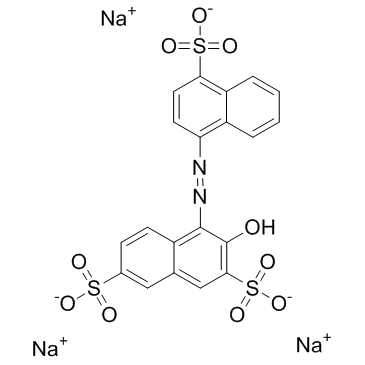Amaranth

Amaranth structure
|
Common Name | Amaranth | ||
|---|---|---|---|---|
| CAS Number | 915-67-3 | Molecular Weight | 604.473 | |
| Density | 1.5 | Boiling Point | N/A | |
| Molecular Formula | C20H11N2Na3O10S3 | Melting Point | >300°C | |
| MSDS | USA | Flash Point | 44ºC | |
|
Evaluation of potential genotoxicity of five food dyes using the somatic mutation and recombination test.
Chemosphere 88(8) , 974-9, (2012) In this study, different concentrations of five food dyes (amaranth, patent blue, carminic acid, indigotine and erythrosine) have been evaluated for genotoxicity in the Somatic Mutation and Recombination Test (SMART) of Drosophila melanogaster. Standard cross... |
|
|
Monoolein cubic phase containing acidic proteinoid: pH-dependent release.
Drug Dev. Ind. Pharm. 37(1) , 56-61, (2011) Monoolein (MO) cubic phase containing acidic proteinoid was prepared for a pH-dependent release.The acidic proteinoid was prepared by a thermal-condensation reaction of Asp and Leu (9.85/0.15 in molar ratio). To prepare MO cubic phase, molten MO was hydrated ... |
|
|
Genotoxicity assessment of amaranth and allura red using Saccharomyces cerevisiae.
Bull. Environ. Contam. Toxicol. 90(1) , 22-6, (2013) Amaranth (E123) and Allura red (E129), very important food azo dyes used in food, drug, paper, cosmetic and textile industries, were assessed for their genotoxic potential through comet assay in yeast cells. Comet assay was standardized by with different conc... |
|
|
Toxicity of xanthene food dyes by inhibition of human drug-metabolizing enzymes in a noncompetitive manner.
J. Environ. Public Health 2009 , 953952, (2009) The synthetic food dyes studied were rose bengal (RB), phroxine (PL), amaranth, erythrosine B (ET), allura red, new coccine, acid red (AR), tartrazine, sunset yellow FCF, brilliant blue FCF, and indigo carmine. First, data confirmed that these dyes were not s... |
|
|
Differential colon DNA damage induced by azo food additives between rats and mice.
J. Toxicol. Sci. 35(4) , 547-54, (2010) Azo dyes, amaranth, allura red and new coccine, which are currently used as food color additives in Japan, have been reported to cause colon specific DNA damage in mice. To examine species difference in the DNA damage between rats and mice, each of dyes was a... |
|
|
Simultaneous kinetic spectrophotometric analysis of five synthetic food colorants with the aid of chemometrics.
Talanta 78(2) , 432-41, (2009) This paper describes a simple and sensitive kinetic spectrophotometric method for the simultaneous determination of Amaranth, Ponceau 4R, Sunset Yellow, Tartrazine and Brilliant Blue in mixtures with the aid of chemometrics. The method involved two coupled re... |
|
|
Morphology-controlled electrochemical sensing amaranth at nanomolar levels using alumina.
Anal. Chim. Acta 764 , 53-8, (2013) Different-shaped aluminas were readily prepared via hydrothermal reaction. It was found that the morphology and the electrochemical sensing properties of alumina were heavily dependent on the reaction time. When extending the reaction time from 6 h to 24 h, t... |
|
|
Role of iron in azoreduction by resting cells of Shewanella decolorationis S12.
J. Appl. Microbiol. 110(2) , 580-6, (2011) To investigate the role of soluble and insoluble iron in azoreduction by resting cells of Shewanella decolorationis S12.A series of analytical experiments were carried out. Results showed that insoluble Fe(2) O(3) all delayed the reduction of amaranth but did... |
|
|
Batch and continuous biodegradation of Amaranth in plain distilled water by P. aeruginosa BCH and toxicological scrutiny using oxidative stress studies.
Environ. Sci. Pollut. Res. Int. 20(5) , 2854-66, (2013) Bacterium Pseudomonas aeruginosa BCH was able to degrade naphthylaminesulfonic azo dye Amaranth in plain distilled water within 6 h at 50 mg l(-1) dye concentration. Studies were carried out to find the optimum physical conditions and which came out to be pH ... |
|
|
Kinetics and mechanism of the oxidation of amaranth with hypochlorite.
J. Phys. Chem. A 115(27) , 7948-54, (2011) The reaction mechanism of the oxidation of Amaranth dye (2-hydroxy-1-(4-sulfonato-1-naphthylazo) naphthalene-3,6-disulfonate) with hypochlorite under varied pH conditions was elucidated by a kinetic approach. Under excess concentration of oxidant, the reactio... |